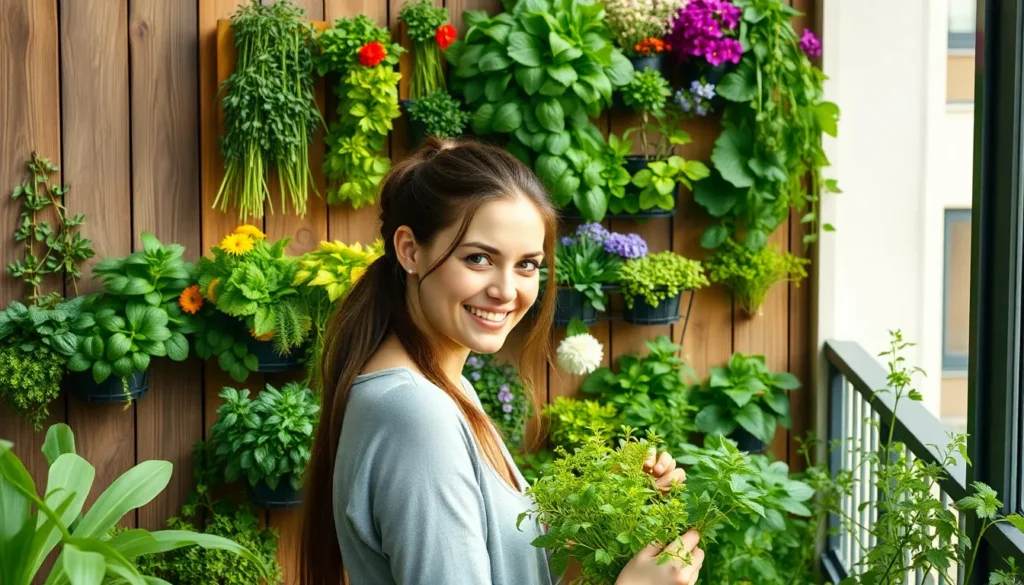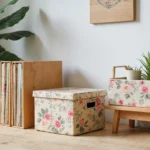We’ve all dreamed of having a lush garden but felt limited by space constraints. Whether you’re living in a tiny apartment or simply want to maximize your outdoor area, vertical gardens offer the perfect solution to transform any wall into a thriving green oasis.
Vertical gardening isn’t just about saving space – it’s about creating stunning visual impact while growing fresh herbs, vegetables, and beautiful flowers right at eye level. From living walls that purify your indoor air to cascading planters that add dimension to your patio, these innovative growing systems make gardening accessible to everyone.
We’ll explore creative vertical garden ideas that’ll revolutionize how you think about growing plants. You’ll discover budget-friendly DIY projects, space-saving designs for small homes, and professional-grade living walls that’ll make your neighbors envious. Ready to grow up instead of out?
Creative Wall-Mounted Vertical Garden Ideas for Small Spaces
Wall mounted gardens transform bare walls into thriving green spaces that maximize every square inch of your home. We’ve compiled innovative answers that work perfectly in apartments, balconies, and compact outdoor areas.
Living Wall Planters and Modular Systems
Modular living wall systems offer the most flexibility for creating stunning vertical displays. These interlocking units allow us to expand our garden as space permits and rearrange plants based on seasonal needs.
Commercial modular planters like Woolly Pocket or VertiGarden systems provide professional results with minimal installation effort. We can mount these lightweight units directly to walls using standard brackets and watch our garden grow vertically in organized tiers.
DIY modular approaches using stackable containers or wooden boxes create custom answers for exact wall dimensions. Mason jars, recycled plastic bottles, or cedar planters work exceptionally well when mounted in grid patterns or staggered arrangements.
Self watering living wall systems eliminate daily maintenance concerns while keeping plants consistently hydrated. These automated answers pump water from reservoirs through tubing networks that distribute moisture evenly across all planting pockets.
Repurposed Pallets and Wooden Structures
Shipping pallets transform into instant vertical gardens with minimal modification and maximum impact. We simply attach industry fabric to the back panel and fill each slat opening with potting soil to create multiple planting levels.
Ladder planters using old wooden stepladders provide rustic charm while maximizing vertical growing space. Each rung holds containers or planters at different heights, creating natural tiers for herbs, succulents, or trailing plants.
Window shutter gardens repurpose old wooden shutters into charming vertical displays perfect for kitchen herbs or colorful annuals. We attach small pots or planters to each slat opening and mount the entire structure against walls or fences.
Cedar fence picket systems offer weather resistant options for outdoor vertical gardening projects. These naturally rot resistant boards accept screws and mounting hardware easily while providing long term durability in various climate conditions.
Hanging Pocket Gardens and Fabric Organizers
Shoe organizers designed for closets become instant vertical gardens when hung on walls or fence panels. We fill each clear pocket with potting mix and plant seeds directly, creating dozens of growing spaces in minimal square footage.
Felt pocket planters provide breathable growing environments that promote healthy root development while preventing water buildup. These soft fabric systems conform to wall irregularities and accommodate various plant sizes from seedlings to mature specimens.
Canvas tool organizers with multiple pockets work exceptionally well for herb gardens near kitchen windows or outdoor cooking areas. We can label each pocket for different herbs and create organized vertical spice gardens that stay within arm’s reach.
Hanging grow bags made from breathable fabric offer deeper root space for larger plants like tomatoes or peppers. These flexible containers adapt to wall mounting systems while providing adequate soil volume for productive vegetable growing.
Indoor Vertical Garden Ideas for Year-Round Growing

Indoor vertical gardens transform your home into a thriving network that produces fresh herbs, vegetables, and flowers regardless of the season. We’ll explore room-exact answers that maximize your growing potential while creating stunning living displays.
Kitchen Herb Gardens on Interior Walls
Pocket planters offer the perfect solution for growing culinary herbs like thyme and oregano in compact kitchen spaces. These fabric or plastic containers mount directly to walls and provide individual growing chambers for different herb varieties.
Material planters create sophisticated vertical displays using wood, metal, or ceramic containers that complement your kitchen’s aesthetic. We recommend choosing planters with drainage systems to prevent water damage to your walls.
Smart gardening systems like Rise Gardens provide integrated answers with mobile apps and nutrient subscriptions that make herb cultivation effortless. These systems include built-in LED grow lights and automated watering schedules.
Stacked planter arrangements maximize vertical space using tiered containers that cascade from ceiling to counter level. This approach works particularly well for growing basil, cilantro, and parsley within arm’s reach of your cooking area.
Bathroom Plant Walls for Humidity-Loving Species
Humidity loving plants thrive in bathroom environments where steam from showers creates ideal growing conditions. Ferns, peace lilies, and spider plants flourish in these naturally moist spaces.
Wall mounted planters provide secure growing spaces without taking up valuable floor space in smaller bathrooms. Choose materials like ceramic or treated wood that resist moisture damage.
Tillandsia displays create striking vertical arrangements using air plants that absorb moisture directly from bathroom humidity. These plants require minimal care and attach to driftwood or metal grids.
Cascading plant arrangements use trailing species like pothos and philodendrons to create living curtains that filter light while adding privacy to bathroom windows.
Living Room Statement Walls with Low-Light Plants
Low light plants like Chinese Evergreen and Pothos create dramatic vertical displays in living rooms with limited natural sunlight. These species adapt well to indoor lighting conditions while maintaining vibrant foliage.
Modular green wall systems allow us to create custom sized living walls that fit any space from small accent walls to entire room features. These systems include built-in irrigation and can accommodate dozens of plants.
Garden towers provide 360-degree growing space for living rooms while serving as sculptural elements that rotate to ensure even light exposure. These systems can support 20-30 plants in a footprint smaller than a traditional houseplant.
Vertical succulent gardens require minimal maintenance while creating geometric patterns and textures that complement modern living spaces. These drought-tolerant plants thrive in bright, indirect light common in living areas.
DIY Vertical Garden Ideas Using Recycled Materials
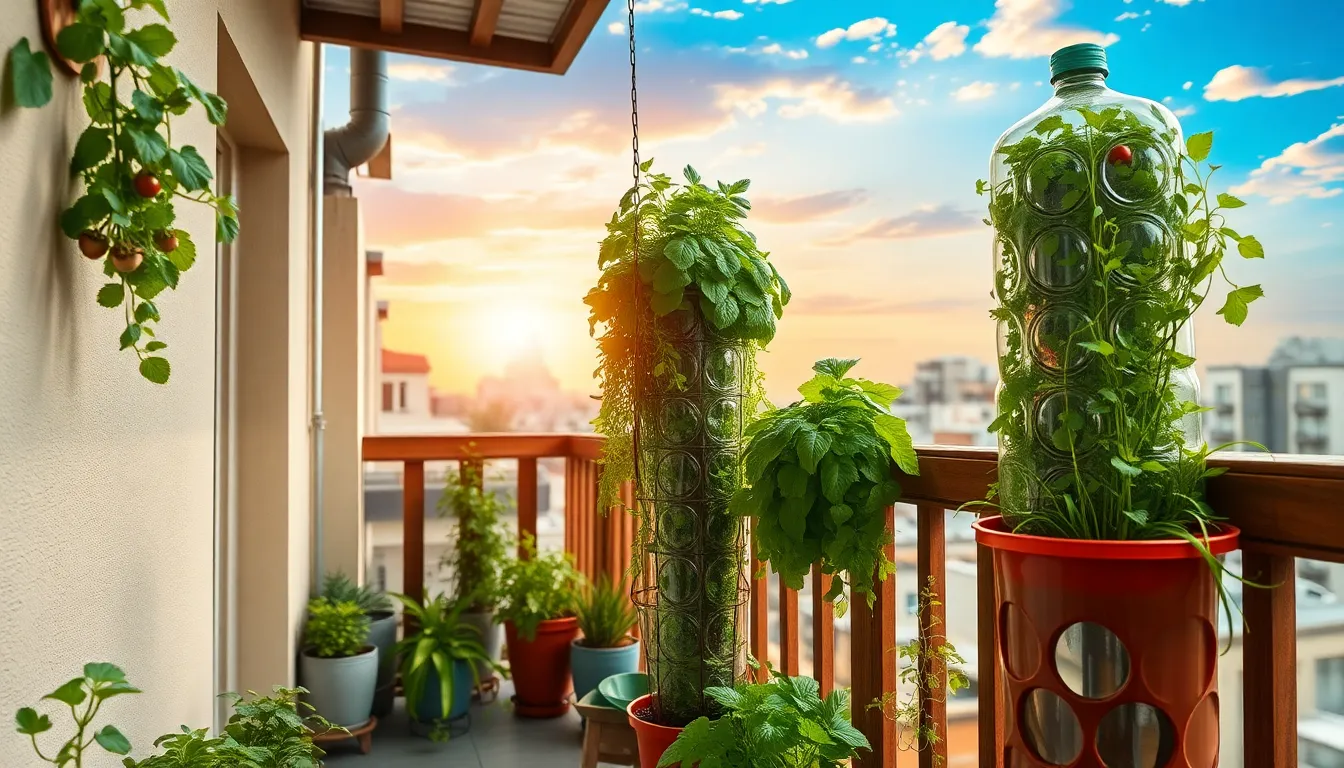
Transform everyday waste into stunning vertical garden displays that cost almost nothing to create. These eco-friendly projects let us repurpose materials while building beautiful growing spaces.
Plastic Bottle Tower Gardens
Plastic bottle towers offer one of the most accessible ways to start vertical gardening with zero waste. We need plastic bottles, scissors, a drill, soil, and our favorite plants to create these hanging gardens.
Cut the bottom off each bottle and drill two small holes on opposite sides for hanging. Fill each bottle with quality potting soil and plant herbs like basil, mint, or small vegetables such as cherry tomatoes. Hang the bottles from a sturdy wall mount or fence using wire or twine, creating cascading towers that maximize growing space in minimal square footage.
These systems work exceptionally well for apartment balconies and small patios where floor space is limited. Multiple bottles can connect vertically to form impressive growing walls that produce fresh ingredients year round.
Old Ladder Plant Displays
Old ladders transform into rustic vertical planters that add character to any indoor or outdoor space. We simply place planters or pots on each ladder rung to create tiered growing displays.
Clean the ladder thoroughly and position it against a wall or fence for stability. Fill various sized containers with soil and arrange them on different rungs to create visual interest. Mix trailing plants like pothos with upright herbs such as rosemary and thyme for ever-changing displays.
Wooden ladders work best for outdoor gardens, while metal ladders suit indoor spaces perfectly. Each rung can hold different plant varieties, creating diverse growing environments from succulents on top rungs to moisture loving ferns on lower levels.
Tire Stack Planters for Outdoor Spaces
Tire stack planters create bold outdoor vertical gardens that withstand weather while recycling rubber waste. We stack old tires and fill each level with soil and plants to build impressive growing towers.
Clean tires thoroughly and stack them securely, using wire or rope to prevent toppling. Fill each tire with quality potting mix and plant vegetables like lettuce, kale, or flowering plants such as marigolds and petunias. The black rubber absorbs heat, creating warm growing conditions that extend the growing season.
These planters work exceptionally well for vegetables that need deep root systems. Stack three to four tires high for optimal plant health, and consider painting them with outdoor paint to match your garden aesthetic.
Vertical Garden Ideas for Balconies and Patios
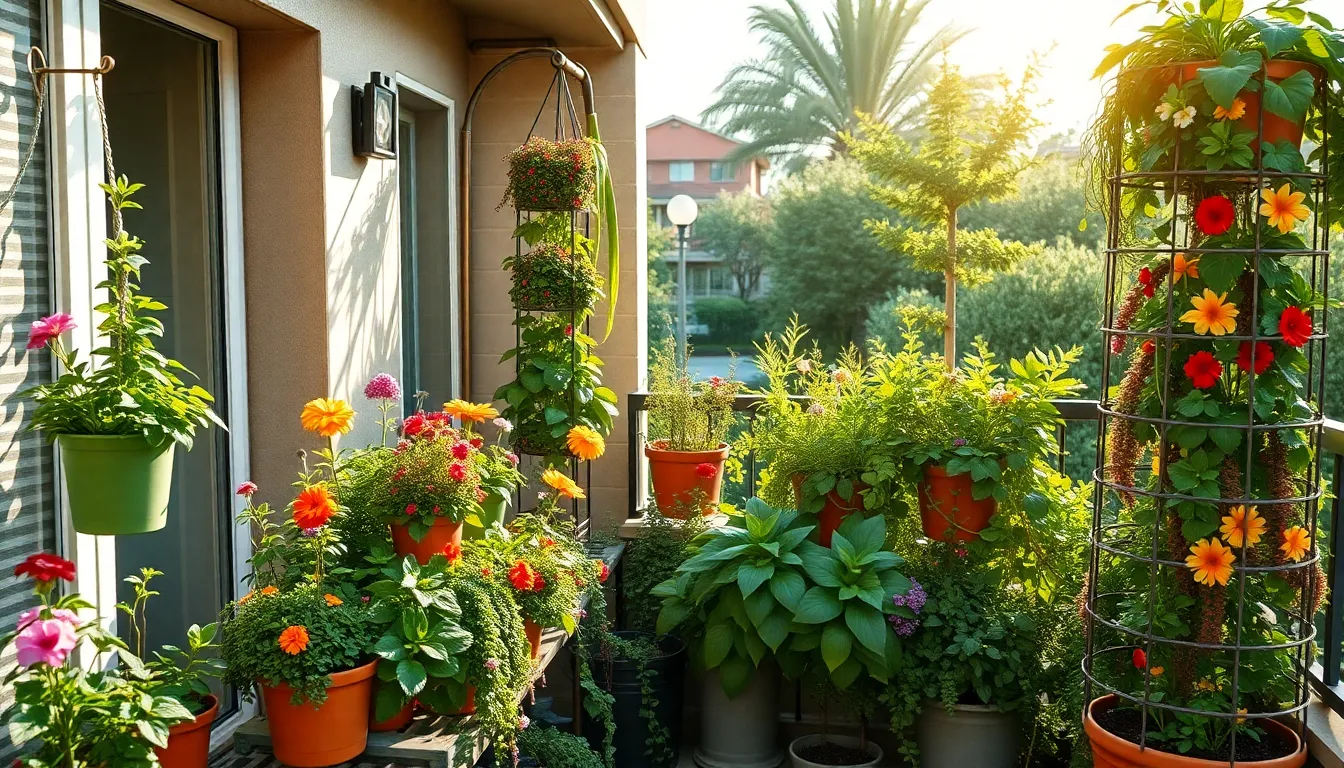
Outdoor vertical gardens transform compact balconies and patios into lush green sanctuaries. We’ve compiled space-maximizing answers that attach directly to existing structures or stand independently to create stunning vertical displays.
Railing-Mounted Planter Systems
Railing-mounted planter systems maximize space efficiency by attaching directly to balcony railings without obstructing views or consuming floor space. These systems integrate seamlessly with existing structures, making them ideal for apartment dwellers who want to maximize their growing potential.
Mounting brackets secure planters firmly to railings, supporting herbs like basil and oregano, or colorful flowers such as petunias and marigolds. We recommend choosing systems with drainage holes to prevent waterlogging and root rot.
Installation requires minimal tools, with most systems featuring adjustable clamps that fit various railing sizes and shapes. Multiple planters can be connected horizontally along the railing length, creating an impressive green border around your balcony perimeter.
Weather-resistant materials like powder-coated steel or UV-treated plastic ensure longevity in outdoor conditions. Some systems include built-in water reservoirs that extend watering intervals and reduce maintenance requirements.
Freestanding Trellis Gardens
Freestanding trellis gardens provide vertical support for climbing plants while creating lush displays that don’t require wall attachment. These versatile structures work equally well on balconies and patios, offering flexibility in placement and design.
Climbing plants like morning glories, clematis, and sweet peas thrive on trellis support, creating natural privacy screens and windbreaks. We suggest choosing plants that match your climate zone and sunlight exposure for optimal growth results.
Materials range from wooden lattice panels to metal wire frameworks, each offering different aesthetic appeals and durability levels. Cedar and teak resist weather damage naturally, while galvanized steel provides long-lasting strength in harsh conditions.
Positioning trellises against walls maximizes space efficiency, or placing them freestanding creates garden room dividers. Multiple trellises can be connected to form larger vertical growing surfaces for expansive plant collections.
Corner Vertical Garden Towers
Corner vertical garden towers use awkward corner spaces efficiently while maximizing vertical growing potential with minimal floor footprint requirements. These towers transform unused corners into productive growing areas perfect for herbs, vegetables, and ornamental plants.
Stacked planter designs allow multiple growing levels within a compact vertical structure, accommodating different plant types at various heights. Larger plants like tomatoes occupy bottom sections, while herbs and flowers fill upper tiers.
Materials include plastic, wood, and metal construction options, each offering different weight capacities and weather resistance levels. Lightweight plastic towers work well for balconies with weight restrictions, while wooden options provide natural aesthetics.
Rotating tower designs enable even sunlight distribution for all plants throughout the day, preventing shadowing issues common in fixed vertical systems. Some towers feature built-in water distribution systems that irrigate all levels simultaneously from a single water source.
Hydroponic Vertical Garden Ideas for Modern Homes

We’re transitioning from traditional soil-based vertical gardens to explore cutting-edge hydroponic systems that revolutionize how we grow plants indoors. These innovative setups combine space efficiency with advanced growing technology to create stunning vertical displays perfect for modern homes.
NFT System Vertical Setups
NFT (Nutrient Film Technique) vertical systems circulate a thin film of nutrient-rich water across plant roots in stacked trays or channels. Systems like these maximize growing space by allowing multiple layers of leafy greens, herbs, and vegetables to flourish simultaneously. We find these setups particularly effective for small apartments and offices where floor space comes at a premium.
Vertical NFT configurations typically feature modular designs that complement contemporary interiors while providing optimal nutrient absorption. Plants receive continuous access to water and nutrients without the bulk of traditional soil, making maintenance surprisingly simple. Gardeners can easily monitor plant health and adjust nutrient levels through accessible channels at each growing level.
Installation requires minimal setup since most NFT systems arrive as complete units ready for immediate use. We recommend these systems for growing lettuce, spinach, basil, and other quick-growing crops that thrive in consistently moist conditions.
Aeroponic Tower Gardens
Aeroponic tower gardens suspend plant roots in the air and deliver nutrients through fine misting systems. Tower designs like Aeva use vertical space efficiently while supporting high plant density in compact footprints. We’ve observed that aeroponics promotes rapid growth and healthier plants due to increased oxygen exposure around root systems.
These striking towers blend seamlessly into modern home decor while providing impressive growing capacity. Root systems develop faster in aeroponic environments since they receive maximum oxygen along with precisely delivered nutrients. Maintenance involves simple monitoring of misting cycles and nutrient solution levels.
Visual appeal makes aeroponic towers excellent conversation pieces that serve dual purposes as functional gardens and artistic installations. We appreciate how these systems eliminate soil mess while creating stunning focal points in any room.
Deep Water Culture Vertical Systems
Deep Water Culture (DWC) vertical gardens immerse plant roots in oxygenated, nutrient-rich water within stacked containers or columns. Air pumps ensure continuous root aeration while vertical configurations maximize growing space in minimal floor areas. We find DWC systems particularly suitable for robust plants like lettuce and other leafy vegetables.
Setup involves connecting multiple growing chambers vertically with shared water circulation and aeration systems. Energy efficiency remains high since these systems require minimal electricity beyond water pumps and air circulation. Maintenance stays simple with easy access to water reservoirs and nutrient monitoring points.
Consistent growth results from the stable environment DWC provides, with plants receiving constant access to water, nutrients, and oxygen. We recommend these systems for beginners since they’re forgiving and require less precise timing than other hydroponic methods.
| System Type | Space Efficiency | Maintenance Level | Best Plants |
|---|---|---|---|
| NFT Vertical | High | Low | Leafy greens, herbs |
| Aeroponic Tower | Very High | Medium | All vegetables, flowers |
| DWC Vertical | High | Very Low | Lettuce, robust plants |
Vertical Garden Ideas for Different Plant Types

Selecting the right plants transforms your vertical garden from a simple space-saving solution into a thriving network customized to your exact needs. Different plant types require unique approaches to maximize their potential in vertical growing environments.
Succulent Wall Gardens for Low Maintenance
Succulent wall gardens offer the perfect solution for busy gardeners who want stunning vertical displays without intensive upkeep. These drought-tolerant plants thrive in bright, direct sunlight and require minimal watering, making them ideal for vertical installations.
Design and Materials
We recommend using breathable materials like industry fabric or mesh to hold soil in place while ensuring proper water drainage. Installing a gutter system catches excess water and prevents damage to walls or floors below your vertical garden.
Plant Selection Strategy
Choose succulents based on your exact care preferences and available light conditions. Popular options include echeveria, sedum varieties, string of pearls, and jade plants that adapt well to vertical growing conditions.
Maintenance Requirements
Pruning and thinning plants prevents overcrowding in your succulent wall garden. Fertilizing during active growing seasons from late winter to early spring provides essential nutrients for healthy growth.
Vegetable Vertical Gardens for Food Production
Vegetable vertical gardens maximize food production in minimal space while providing fresh produce throughout the growing season. These practical installations transform any vertical surface into a productive food source.
Structural Design Elements
Slatted wooden structures or trellises provide essential support for vining vegetables like tomatoes and cucumbers. These frameworks distribute plant weight evenly while allowing adequate air circulation between growing levels.
Soil and Irrigation Systems
Well-draining soil mixtures combined with integrated irrigation systems ensure efficient water distribution throughout your vertical vegetable garden. Drip irrigation or soaker hose systems deliver consistent moisture without oversaturating plant roots.
Optimal Plant Varieties
Select compact varieties or plants with natural vining habits for maximum success in vertical growing environments. Leafy greens like lettuce and spinach, culinary herbs, and cherry tomatoes perform exceptionally well in vertical vegetable gardens.
Flowering Plant Walls for Color and Fragrance
Flowering plant walls create spectacular visual displays while filling outdoor spaces with natural fragrance and vibrant colors. These installations serve as living artwork that changes throughout the growing seasons.
Framework and Support Systems
Sturdy frames with secure backing materials hold soil and plants safely in vertical arrangements. We suggest using galvanized steel or treated wood frameworks that withstand weather conditions while supporting mature flowering plants.
Plant Selection for Visual Impact
Choose flowering plants like climbing ivy, roses, or jasmine that thrive in vertical growing conditions. These varieties produce cascading blooms while establishing strong root systems in confined vertical spaces.
Care and Maintenance Practices
Adequate sunlight exposure and consistent moisture levels promote healthy flowering throughout the growing season. Regular pruning encourages blooming while preventing overgrowth that can overwhelm your vertical flower garden’s structure.
Professional Vertical Garden Ideas for Commercial Spaces
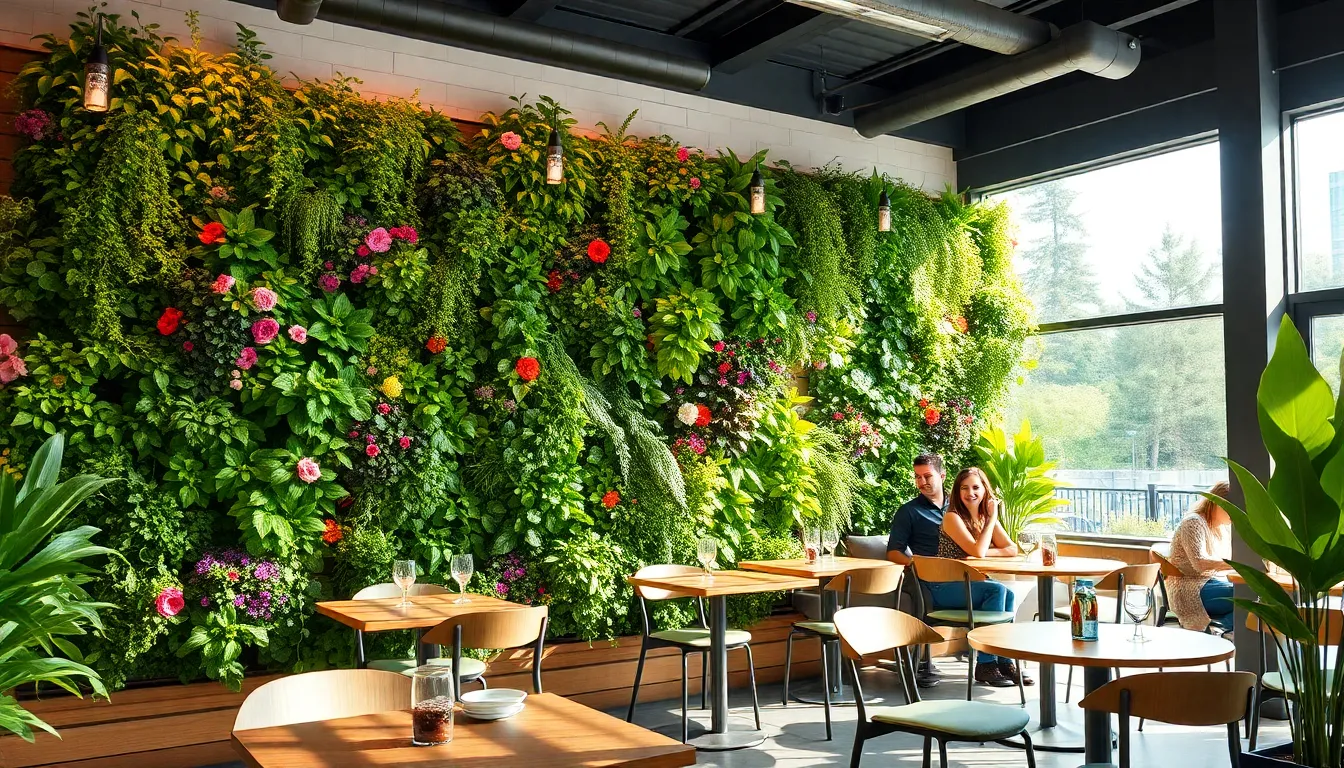
Commercial spaces benefit significantly from vertical garden installations that enhance aesthetics while providing environmental and wellness advantages. These professional applications transform business environments into healthier, more productive spaces.
Office Building Green Walls
Office building green walls transform sterile corporate environments into vibrant, living spaces that enhance employee wellbeing. We recommend installing modular panel systems or hanging planters along empty wall surfaces to create striking visual features. These installations improve indoor air quality while boosting employee morale and productivity according to workplace wellness studies.
Maintenance becomes effortless when we select low maintenance plants like pothos, ferns, or philodendron for these commercial installations. Integrated lighting systems provide consistent illumination for plant health, while automated irrigation systems ensure proper watering without daily intervention. The modular design allows for easy plant replacement and seasonal updates to keep displays fresh throughout the year.
Restaurant and Cafe Living Walls
Restaurant and cafe living walls create welcoming atmospheres that attract customers while serving practical functions. We often design these installations as natural room dividers between dining areas, adding privacy without blocking sightlines completely. The living wall concept works exceptionally well in hospitality environments where ambiance directly impacts customer experience.
Edible plant integration sets restaurant vertical gardens apart from standard decorative installations. Herbs like basil, mint, and oregano provide fresh ingredients for kitchen use, while lettuce varieties and edible flowers create unique garnish opportunities. LED grow lights maintain consistent plant health regardless of natural lighting conditions, ensuring year round productivity for culinary applications.
Retail Store Vertical Garden Displays
Retail store vertical garden displays enhance shopping experiences by creating memorable brand impressions that set businesses apart from competitors. We design these installations as freestanding structures or wall mounted planters featuring colorful foliage and seasonal flowering plants. The visual impact attracts customers while reinforcing brand values related to sustainability and environmental consciousness.
Customization options allow retailers to align displays with store themes and seasonal promotions. Plant rotations keep displays captivating throughout different seasons, while modular construction enables easy updates for holidays or special events. These installations make efficient use of limited floor space while providing air purification and temperature regulation benefits that improve overall shopping comfort.
Conclusion
We’ve explored how vertical gardens transform any space into a thriving green sanctuary regardless of your available square footage. From simple DIY projects using recycled materials to sophisticated hydroponic systems these answers adapt to every skill level and budget.
Whether you’re growing fresh herbs on your apartment balcony or installing a professional living wall in your office the possibilities are endless. The key lies in selecting the right plants and systems that match your exact environment and maintenance preferences.
Your vertical garden journey starts with a single planter mounted on a wall. We encourage you to experiment with different approaches and discover which vertical gardening style works best for your unique space and lifestyle.
Frequently Asked Questions
What is vertical gardening and who is it for?
Vertical gardening is a space-saving technique that allows you to grow plants upward instead of outward, making it perfect for apartment dwellers and anyone with limited space. It enables you to grow fresh herbs, vegetables, and flowers at eye level while creating visually appealing green walls.
What are some budget-friendly DIY vertical garden ideas?
You can create affordable vertical gardens using repurposed materials like plastic bottles for tower gardens, old wooden ladders as plant displays, and shipping pallets as wall-mounted planters. These DIY projects maximize space while minimizing costs through creative recycling.
Can I grow vertical gardens indoors year-round?
Yes, indoor vertical gardens allow continuous growing throughout the year. You can install pocket planters in kitchens for herbs, wall-mounted planters in bathrooms for humidity-loving plants, and modular living wall systems in any room with adequate lighting.
What types of plants work best for vertical gardens?
Succulents are ideal for low-maintenance vertical gardens, while leafy greens and herbs work well for vegetable walls. Flowering plants create vibrant displays, and you should choose plants based on light requirements, weight, and root system compatibility with your vertical structure.
How do hydroponic vertical gardens work?
Hydroponic vertical gardens use water-based nutrient systems instead of soil, including NFT (Nutrient Film Technique), aeroponic towers, and Deep Water Culture systems. These advanced setups offer superior space efficiency and often require less maintenance than traditional soil-based gardens.
Are vertical gardens suitable for outdoor spaces like balconies?
Absolutely! Outdoor vertical gardens work excellently on balconies and patios using railing-mounted planters, corner tower gardens, and wall-mounted systems. These solutions maximize growing space while maintaining accessibility for maintenance and harvesting.
What are the benefits of professional vertical gardens in commercial spaces?
Commercial vertical gardens enhance employee wellbeing and productivity in offices, serve as natural dividers in restaurants while providing fresh ingredients, and create unique customer experiences in retail stores. They also reinforce brand values and can be customized seasonally.
How do I maintain a vertical garden properly?
Maintenance involves regular watering through integrated irrigation systems, selecting appropriate plants for your light conditions, using breathable materials for proper drainage, and choosing low-maintenance varieties when possible. Proper framework and structural support are essential for long-term success.

